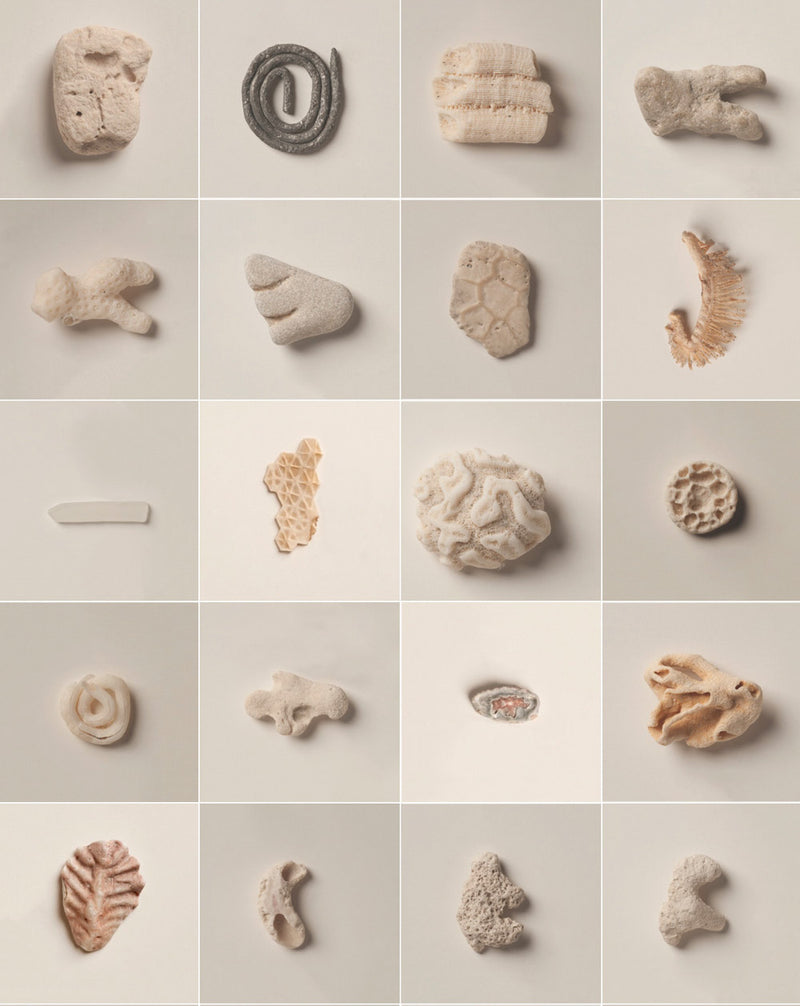
Tra Publishing talks with Michele Oka Doner, an internationally renowned artist. Her book Intuitive Alphabet, available in both a trade edition and a collector's edition, pays homage to curiosity, discovery, and nature while also investigating how language has evolved and is learned. We discuss her inspirations and the importance of connecting to the world around us.
Oka Doner views Intuitive Alphabet as, literally, a gift from the sea, like life itself. She grew up in Miami Beach combing the sand for treasures—shells, stones, coral—that formed her own "alphabet" well before she knew how to read. In Intuitive Alphabet, an homage to that world of discovery, she explores the glyphic forms embedded in the treasures she has collected during a lifetime of walks on the beach. Intuitive Alphabet is both an artist’s book and an alphabet book, one which conveys a profound message about looking and seeing.
Oka Doner's artistic production encompasses sculpture, prints, drawings, furniture, jewelry, public art, functional objects, video, costume and set design, and artist’s books. She is well known for such permanent art installations as Flight at Reagan International Airport, Radiant Site at the Herald Square 34th Street Subway Station, and A Walk on the Beach, the mile-and-a-quarter-long bronze terrazzo concourse at Miami International Airport. Oka Doner’s work is found in the collections of the Metropolitan Museum of Art, the Whitney Museum of American Art, The Art Institute of Chicago, the Victoria & Albert Museum, and the art museums at Yale, Harvard, and the University of Michigan, where she received her BSD and MFA art degrees and was recently awarded an honorary Doctor of Fine Arts.

How did your childhood influence Intuitive Alphabet in particular, and your work in general?
I grew up in a time and place -- Miami Beach, Florida -- that was filled with pulsing, aggressive nature. One of my early memories engages all the senses: a huge mango tree that dominated the backyard of our first home. Cycles of flowering, fruiting, and decay seemed to take up the entire space. From a child’s perspective, the tree occupied too much sky, blocking sunshine, creating deep shade. Countless fruits dropped seasonally, too numerous for a family to consume, and inevitably, the smell of rotted mangos permeated everything. Bees arrived in droves to feast on the sap and juice. To this day the scent of mango trees in bloom stirs me, bringing me back to childhood, and leaves me somewhat uneasy.

Your work is prolific in scope and range -- from sculpture, furniture, jewelry, and video to costumes, set design, and large-scale public art installations. Is there is a common thread?
The common thread running through my oeuvre is my lifelong study and appreciation of the natural world from which I derived a formal vocabulary.
Intuitive Alphabet is not specifically a children’s book, yet it is accessible to children, a book to be shared by generations. How can we encourage children to examine, consider and respond to the world around them?
The exploration of nature into language has fascinated me since childhood. It seems almost magical, like incantations. It is also universal, as most of us see. Intuitive Alphabet reminds children, as well as adults, to look at the natural world, to understand how much we depend on nature for sustenance in all ways.
How does language influence our relationship with the natural world and vice versa?
I have always been a hunter-gatherer, first and foremost. Translating my finds into clay allowed me to expand the impulse. No longer was the peach pit extracted from the ripe stone fruit just detritus. I could take it to the studio, study the interior structure, and a landscape emerged. Bones from Cornish hen and ox tails were extracted from the nightly dinner table to meet this scrutiny. (The vertebra from the spine of the hen became a wondrous crown as seen in the Burial Pieces poster.) My collection of seeds and pods evolved over the course of a few years, and as I worked, the intense awareness of form moved me in the direction of pictographs. I thought I could imagine, almost touch, the impulse to write that sparked our ancient ancestors, that led to the first glyphs. I began to notice symbolic language everywhere, in branching twigs, twisted coral, water worn rocks, and even the organs of our very human bodies. I was creating my own archaeology, developing language for life’s ongoing dialogue. The intense awareness of form and ensuing consciousness moved me in the direction of pictographs.

Can you tell us about the Collector's Edition of the book?
The Collector’s Edition is an oversized version of the trade edition of Intuitive Alphabet. Each cover has a hand-written title and is crafted of handmade paper that has a naturally deckled edge. The Collector’s Edition is designed to celebrate the traditional form of bookmaking in its purest sense. The spine is left raw to reveal the sewn-together pages. The uncoated textured paper is recycled postconsumer overlaid with transparent sheets.
Why are proceeds from the Collector’s Edition of Intuitive Alphabet going to Oceana?
Oceans cover 71 percent of the globe, aare home to most of the life on our planet, and play a central role in the world’s natural systems, such as regulating our climate. We have already altered or destroyed marine ecosystems and driven million-year-old species to the brink of extinction. All proceeds from the Collector’s Edition will benefit Oceana’s efforts at protecting the earth’s 1.6 million square miles of ocean.
Buy Intuitive Alphabet Collector's Edition


